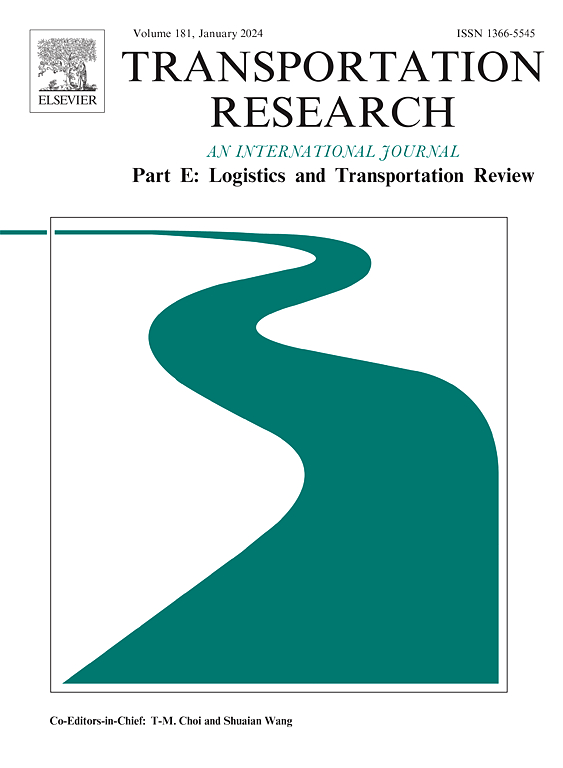Generic model for capacity allocation on transportation terminals
IF 8.3
1区 工程技术
Q1 ECONOMICS
Transportation Research Part E-Logistics and Transportation Review
Pub Date : 2025-02-25
DOI:10.1016/j.tre.2025.104017
引用次数: 0
Abstract
Transportation terminals play an important role in the functioning of the transportation system. Therefore, the efficient use of the capacity of transportation terminals is considered a major determinant of the performance of transportation networks. An important decision related to the efficient functioning of congested terminals relates to the optimum allocation of the available capacity to different operators (users). The capacity allocation problem in transportation terminals, such as airports, railroad stations, ports, involves the optimum apportion of the available capacity to different users, such as airlines, rail, and shipping companies, while satisfying operational, and regulatory constraints and requirements. Motivated by the similarities across capacity allocation problems in terminals of different transportation modes and the lack of a unifying framework, this study introduces a generic mixed integer linear programming (MILP) formulation and demonstrates its applicability through a detailed application of the proposed model for rail networks. The generic mathematical model is a generalization of models highly utilized in airport slot allocation. We explicitly present how the model applies to the train timetabling problem and conduct computational experiments using publicly available data. Our computational experiments show that the model consistently achieves optimal solutions across almost all tested cases, including instances where published solutions are suboptimal. The analysis of the results for a specific instance indicates that incorporating station capacity constraints yields the same set of scheduled requests but alters the deviations from the desired arrival and departure times. In contrast, increase in the flexibility of the requested times significantly affect the solution, leading to increase in the number of scheduled trains, deviations, and the overall length of the journey.
运输码头运力分配的通用模型
运输终端在运输系统的运行中起着重要的作用。因此,运输终端容量的有效利用被认为是运输网络性能的主要决定因素。与拥挤终端的有效运行有关的一个重要决策涉及到对不同运营商(用户)的可用容量的最佳分配。运输终端(如机场、火车站、港口)的容量分配问题涉及到将可用容量最优地分配给不同的用户(如航空公司、铁路公司和航运公司),同时满足运营和监管约束和要求。考虑到不同运输方式的终端容量分配问题之间的相似性以及缺乏统一的框架,本研究引入了一种通用的混合整数线性规划(MILP)公式,并通过所提出模型在铁路网络中的详细应用证明了其适用性。该通用数学模型是机场机位分配中常用模型的一般化。我们明确地展示了该模型如何应用于列车时刻表问题,并使用公开可用的数据进行计算实验。我们的计算实验表明,该模型在几乎所有测试用例中始终如一地获得最优解,包括发布的解决方案不是最优的实例。对一个具体实例的结果分析表明,将车站容量限制考虑在内会产生相同的一组预定请求,但会改变与期望到达和离开时间的偏差。相反,增加请求时间的灵活性会显著影响解决方案,导致计划列车的数量、偏差和旅程的总长度增加。
本文章由计算机程序翻译,如有差异,请以英文原文为准。
求助全文
约1分钟内获得全文
求助全文
来源期刊
CiteScore
16.20
自引率
16.00%
发文量
285
审稿时长
62 days
期刊介绍:
Transportation Research Part E: Logistics and Transportation Review is a reputable journal that publishes high-quality articles covering a wide range of topics in the field of logistics and transportation research. The journal welcomes submissions on various subjects, including transport economics, transport infrastructure and investment appraisal, evaluation of public policies related to transportation, empirical and analytical studies of logistics management practices and performance, logistics and operations models, and logistics and supply chain management.
Part E aims to provide informative and well-researched articles that contribute to the understanding and advancement of the field. The content of the journal is complementary to other prestigious journals in transportation research, such as Transportation Research Part A: Policy and Practice, Part B: Methodological, Part C: Emerging Technologies, Part D: Transport and Environment, and Part F: Traffic Psychology and Behaviour. Together, these journals form a comprehensive and cohesive reference for current research in transportation science.

 求助内容:
求助内容: 应助结果提醒方式:
应助结果提醒方式:


